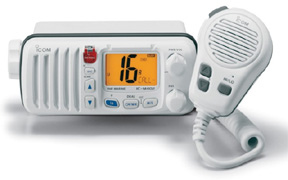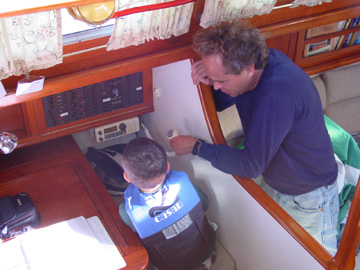(Shared)
VHF Radio Basics.Registration, operation and etiquette!III: Radio Protocol and Etiquette
Obscene or objectionable language, transmission of music, and subversive transmissions are forbidden. There are individuals monitoring the airwaves and the Coast Guard can locate the origins of signals. The consequences can be severe. Children should be taught proper radio use and should never be left unattended near a radio. To hail another vessel, simply call the name of the vessel two or three times, followed by your own vessel’s name and station ID if applicable. Wait for a response then immediately switch to a working channel. For example, depress the microphone key and say “Seascape, Seascape, Seascape, this is Espresso WDA9048 on channel 16, over.” You must release the key to hear a response. The term “over” let’s the listeners know you are releasing the key. The response might be, “Espresso, this is Seascape. Switch channel 68, over.” Espresso would answer, “Espresso switching 68.” Both vessels switch their radios to 68, hail each other and converse normally. At the end of the conversation, “Espresso returning to stand by channel 16,” or “Seascape out.” The term “out” signifies that you are terminating the conversation. Never say "over and out." Those are conflicting terms. All ships should maintain watch on channel 16 (156.800 MHz) when within the service area of a VHF maritime coast station and while at sea. Ships with digital selective calling-equipped VHF marine radios should also keep watch on channel 70. After February 1, 2005 ships over 300 tons and passenger ships will no longer be required to monitor channel 16 but will be required under international law to monitor channel 70 for DSCSS signals. Vessels not required to carry a marine radio (e.g. recreational vessels less than 20m length), but which voluntarily carry a radio, must maintain a watch on channel 16 whenever the radio is operating and not being used to communicate. Such vessels may alternatively maintain a watch on VHF channel 9 (156.450 MHz), the boater calling channel. Note however that urgent marine information broadcasts, such as storm warnings, are announced on channel 9 only in First CG District waters (northern New Jersey , New York and New England ). U.S. vessels required to carry a VHF marine radio, such as commercial fishing vessels, must maintain a watch on channel 16 (156.800 MHZ) while underway whenever the radio is not being used for exchanging communications. Every power-driven vessel of 20m length or greater, every vessel of 100 tons and upward carrying one or more passengers for hire, every towing vessel of 26 ft length or greater, and every dredge and floating plant near a channel or fairway, must maintain a watch on both VHF channels 13 (156.650 MHz) and 16 (156.800 MHz) while the vessel is underway.
Basics for radio etiquette and protocol include:
One additional rule to mind is that VHF radio is for use only on the water. Shore use is permitted only with a special land based radio permit which is what yacht clubs and marinas have which allows them to talk from the dock house to vessels on the water. If you go ashore with your handheld and you call someone aboard your vessel, you are in violation of the law. For that use, FRS two-way radios that now have suitable range for contact within several miles’ radius are widely available and great for staying in touch with your shore crew. They are also quite useful for communicating from above decks to below and bow to stern while anchoring. Some radios are now even available with VHF and FRS frequencies built in. Visit http://www.navcen.uscg.gov/marcomms/default.htm for up to date information about designated marine frequencies. Please also keep in mind that the Mayday call is only for situations in which life or property is in immediate danger. It is not for calling for help if you've run out of fuel, unless you are in imminent danger (eg, in a channel without an anchor and without alternative propulsion about to go up on rocks). When you call mayday, you are setting the search and rescue operations into immediate action. If you run out of fuel, run aground, or have an engine problem that is not an immediate threat, hail your towing service or the local coast guard for referral to the local towing service. You may also consider issuing a securite warning to other vessels. If you perceive danger but it's either not identifyable or not imminent, you may issue a pan pan which gets everyone to listen up for further updates. So the sequence of radio distress calls is as follows: Least threatening: Securite, securite, securite (you are towing someone and have restricted maneuverability and you want all others to avoid you or to let you know if there's a potential issue) Moderately threatening: Pan pan, pan pan, pan pan (you have grounded and believe you may be taking on water slowly or are a hazard to navigation) Immediate danger and distress: Mayday, mayday, mayday (your ship is going down, you've lost someone overboard, your vessel is being smashed on rocks, etc) Note: On HAM radio frequencies, Break, Break, Break is the equivalent of Mayday, mayday, mayday. Never use the term "Break" three times unless there is immediate threat to life or property. US Radio Watchkeeping Regulations for Recreational Vessels in US WatersU.S. recreational vessels not required to carry radios These rules apply to all foreign vessels, recreational vessels, federal government and military vessels as well as commercial vessels, operating within U.S. territorial waters. These rules also apply to vessels on the Great Lakes and their connecting and tributary waters. To view the Top 100 Marine VHF/SSB/HAM Radio Frequencies, click here. To learn about licensing requirements, click here.
Securite calls and pan pan calls are best left to the Coast Guard. Hail the coast guard with your concerns and let them make the call. Exceptions are if you want people to call you back directly.
|
|
Replies to This Discussion
-
New generation marine VHF radios with the Global Marine Distress Safety System(GMDSS) technology usually also include Digital Selectice Calling (DSC) features as well. DSC is a semi-automated method of establishing a radio call, leaving the operator free to deal with other responsibilities.
/
To utilize these features you must register your DSC radio with the FCC to receive your nine digit Marine Mobil Service IDentity (MMSID) number. This can be done for free online at the BOAT U.S. web site, members and non-members alike.
/
In addition to enabling the distess button call system on your VHF radio, it will allow others that you give your MMSID number to, to hail your vessel using the DSC technology. If someone should hail you, your VHF radio will emit a loud tone unique to the DSC function, alerting you of the hailing. It does not matter what channel you are guarding, or even if your volume knob is turned down. It will then automatically switch your VHF to the caller's selected comm channel for voice communication and display the caller's ID data block information.
/
If your radio is on, but you are unavailable to receive the caller, the radio will log the caller's ID data block and time of hail and note the missed call(s) on the LCD display for resolution. The volume can be turned completely down for this eliminating any annoying or distracting radio traffic, especially if you are anchored but wish to remain reachable to those you have given your MMSID number to.
© 2024 Created by CAN DRAC.
Powered by
![]()






